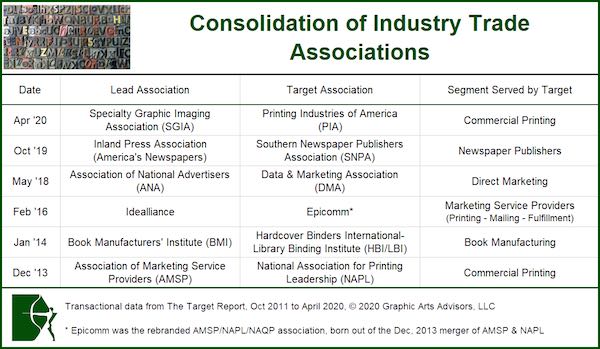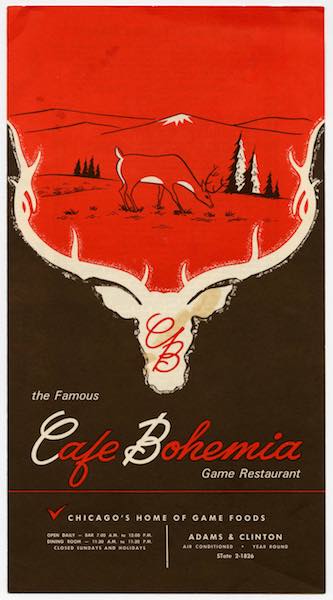
The long and winding road of industry consolidation among the associations serving the printing and related industries may have finally reached its ultimate conclusion with the recently announced merger of the Specialty Graphic Imaging Association (SGIA) and Printing Industries of America (PIA). The merger was widely expected, makes sense, and is reflective of the ongoing consolidation in the highly fragmented and diverse universe of companies that make up the industry. As technology has driven convergence in the service offerings at many printing companies, that convergence in turn has created a commonality among companies that apply images to a substrate. Paper printed on an offset press, dry toner applied via laser imaging to pre-printed masters, liquid toners creating one-of-a-kind labels in rapid sequence, latex inks printed onto rolls of fabric for trade show exhibits, flatbed UV inkjet wide-format printers creating retail environments...I could go on, but you get the idea, printing companies are offering all types of unique applications utilizing a wide variety of print technologies. Many print-centric companies no longer are limited to one strict silo of technological expertise serving a highly defined and segmented customer base. As the industry converges and consolidates, so have the many trade associations, probably best exemplified by the merger of SGIA and PIA.

The trade associations have evolved, right along with the industry segments they serve. The SGIA moniker was adopted in 1995 when the Screen Printing Association (SPA), originally established in 1948, first recognized its members’ growing use of digital technologies and changed the association name to the Screen Printing & Graphic Imaging Association International (SGIA). When SGIA consolidated the Digital Printing & Imaging Association (DPIA) and the Screen Printing Technical Foundation (SPTF) into the organization, they managed to find a name that retained the acronym, rebranding to the Specialty Graphic Imaging Association (SGIA). However, “SGIA” is apparently now on the way out since the new name for the merged SGIA/PIA organization, just announced, will be the Printing United Alliance (PUA anyone?).
The other half of the merged entity, Printing Industries of America (PIA), is also a roll-up of organizations. In 1999, PIA absorbed the research-based Graphic Arts Technical Foundation* (GATF) which traced its roots back to 1924. Unlike the SGIA, the PIA is a chapter-based organization with semi-independent regional chapters throughout the US. The alphabet soup within the PIA is extensive; there’s the PMA (Print Media Association of Missouri), the PICA (Printing Industry of the Carolinas), the PIAS (Printing Industries of the South), the WSPA (Western States Printing Alliance), the PPI (Pacific Printing Industries Association, which includes Alaska, Hawaii, Idaho, Montana, Oregon, Utah, and Washington), the aptly named PINE (Printing Industries of New England), the MPIA (Manitoba Print Industry Association), the FGA (Florida Graphics Alliance), GAA (Graphic Arts Association in Delaware, Southern New Jersey and Pennsylvania; not to be confused with the GAA that publishes this report), the GLGA (Great Lakes Graphics Association), PIM (Printing Industry Midwest), PIA MidAmerica (Printing & Imaging Association of MidAmerica) and several others including my local chapter, based in New York State, the PIA (Printing Industries Alliance—yes, there is even a PIA chapter of the PIA).
And whatever happened to the venerable NAPL? Founded in 1933 by an accountant, among others, the National Association of Photo Lithographers (NAPL) brought financial discipline and standards to the new and growing industry based on offset lithography which was displacing letterpress printing as the primary method of print reproduction. By 1971, the name had become anachronistic, the “photo” prefix being superfluous. NAPL responded by a simple name change to the more inclusive National Association of Printers and Lithographers (NAPL). As digital technologies took hold of the industry, NAPL expanded beyond its traditional financial focus. The association had evolved to address a broader range of management concerns and the name was changed in 1999 to the National Association for Printing Leadership (NAPL). In 2006, NAPL absorbed the National Association of Quick Printers (NAQP), retiring the NAQP moniker for the time being.
When merger talks between PIA and NAPL fell through in 2012, the pressure to consolidate trade associations did not go away, it simply shifted to another target. In 2013, NAPL merged with the Association of Marketing Service Providers (AMSP) which was the rebranded name for the former Mailing & Fulfillment Service Association (MFSA). In the ultimate alphabet soup incarnation, the group resurrected the NAQP brand and operated for more than a year with the improbable name AMSP/NAPL/NAQP. Given the difficulty of maintaining a coherent brand identity with a 12-letter acronym, AMSP/NAPL/NAQP engaged a branding agency to conjure up a new name. The result was that in 2015 the NAPL brand disappeared into the new name for the merged entity, Epicomm. A bit more than a year later, the Epicomm name itself disappeared with its merger into Idealliance. Focused on establishing color standards and related training, Idealliance has eschewed the vestiges of trade association functions. In the meantime, the former NAQP members, primarily owners of smaller printing companies, never quite felt well-served by the merged associations, and a spin-off group had emerged to form the National Print Owners Association (NPOA). The eventual melting away of the NAPL legacy has paved a clear path for SGIA and PIA to merge and take on the mantle of being the lead trade association for the industry.
Commercial Printing and Diversified Services
As noted in last month’s Target Report, deal activity declined dramatically as the country shut down due to the outbreak of COVID-19, and we expect that it will take several months for buyers and sellers to return to the market in numbers consistent with the past (see The Target Report: The Lull Before the Storm, March 2020). However, we do expect that activity will pick up soon in the commercial printing segment, and that the first wave of transactions will be “tuck-in” deals in which the customers of the acquired company are transitioned to the buyer’s production facility. In these tuck-in transactions, buyers will often leave the disposition of the plant and equipment to the seller, or to the seller’s agent, avoiding responsibility for trade and other debt, possibly “cherry picking” certain equipment that is needed or desirable for the smooth continued servicing of the acquired customers.
Kingston Printing, a commercial printing company in the Kansas City region with $6 million of revenues in 2019, has acquired the business of Richardson Communications Group, a slightly smaller diversified commercial printing and fulfillment services company serving regional and national clients.** Operations are being consolidated into the Kingston facility in a classic well-structured tuck-in transaction. Richardson brings national clients, selected equipment, highly qualified personnel, client-branded websites, and a sophisticated fulfillment operation to the newly combined operation.
LCP (formerly known as Lake County Press), a diversified commercial printing operation in Waukegan, Ill., with more than $38 million in revenue in 2019, has acquired the customer assets of eDOC Communications, a commercial printing company located in Mount Prospect, Ill. Management at LCP noted that the transaction did not include taking over any operations at the eDOC facility and that LCP was not acquiring any of eDOC’s equipment. The owners of eDOC Communications pointed to the COVID-19 crisis as the critical factor driving their decision to tuck-in their customer base with LCP at this time.
* In addition to providing research and training, GATF sponsored annual industry-backed scholarships. As the recipient of a GATF scholarship, based on my academics and an inexplicable interest in spending time in the high school print shop (yes, there were real printing shops in many high schools at the time; ours included two “AB Dicks,” two “Pilot Presses,” a dark room for developing orthochromatic film, and the most interesting of all, a “Heidelberg Windmill” letterpress). In my senior year of high school, GATF treated me to an all-expense paid trip to the Print 74 trade show at McCormick Place in Chicago. Upon entering the main hall, there was a four-color Heidelberg press running full speed with all the hiss and rumble of a big press, folders clacking away, stitchers swishing along, producing beautiful full-color booklets right there on the show floor. I still remember the theme of the booklets which described the benefits of America switching to the metric system (which was a big topic at the time). GATF and that trip to Print 74 changed my life; that was it for me, this printing industry thing was exciting and big business. GATF had accomplished their goal and had another convert to the industry.
The funding for the scholarship was provided by Bell & Howell, which at the time owned the Baumfolder company, hence the connection to our industry. If I and the other three young scholarship recipients had any doubt that printing was a good industry for our serious consideration, the B&H executives made sure that top-notch treatment was part of the agenda. The most memorable part of the trip (other than the big presses) was Cafe Bohemia, billed as having “Chicago’s Most Unusual Menu” with a selection of truly unusual North American game such as grizzly bear, elk, antelope, and beaver, and also exotic selections from around the globe. The waiter informed our table that one of the specials that evening was Braised Strips of African Lion (served in a Grand Marnier Sauce). He added that, notably, this night was the last day that lion could be legally served in the US, and lion would no longer be available henceforth. Of course, I ordered the lion.

Cafe Bohemia Menu, circa 1964.
** Graphic Arts Advisors, publisher of The Target Report, served as exclusive advisors to Richardson Communications Group in this transaction.
View The Target Report online, complete with deal logs and source links for April 2020.


















Discussion
Only verified members can comment.